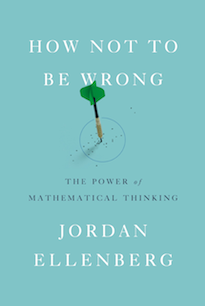By Douglas Whitaker
If you have never been exposed to math outside of a classroom, Jordan Ellenberg wants an opportunity to change your opinion of it. Ellenberg recognizes that mathematics can be simple or complicated, shallow or profound. The world of computations and derivations that many imagine mathematics to be is really shallow, irrespective of how complicated might be. Rather, real mathematics is profound, eminently practical, and “enriches your knowledge about the world.” The work professional mathematicians do may be complicated, but How Not to Be Wrong promises to make the world of profound mathematics accessible to all through “ideas that [are] simpler, older, and just as deep.”
How Not to Be Wrong is organized around a few powerful mathematical ideas, including but not limited to linearity, statistical inference, and expected value, with several chapters devoted to each. Chapters begin with a situation that mathematical thinking will illuminate followed by a series of loosely-related vignettes that introduce the tools and connections among tools necessary for addressing the situation. These vignettes are where the book shines. Ellenberg does an admirable job balancing the level of detail provided: enough detail is given to ensure that the idea is faithfully presented, while not providing so much that the reader is overwhealmed. At times, such as when calculating conditional probabilities, Ellenberg’s attention to detail and decision to favor prose over formulas make some paragraphs a chore to read. Such paragraphs are thankfully rare, and on the whole, the level of detail provided is appropriate. Ellenberg does not want to use hand-waving measures to convince the reader of anything.
The contexts and situations from which the vignettes are drawn are comfortingly varied, an argument in itself that the mathematical thinking espoused in How Not to Be Wrong actually is useful nearly everywhere. No single area of mathematics dominates How Not to Be Wrong, but geometry, probability, and statistics may be the most visible. The lines often blur between mathematical disciplines and motivating contexts, and psychology, economics, voting systems, digital signal processing, and religion are all discussed, among many other areas. Similarly, some of the mathematical concepts – such as expected value and linearity – developed in the vignettes are used throughout the book, an example of how important ideas may be motivated by one context and yet be nearly universally applicable.
The vignettes include more than just mathematical content, and even readers who have encountered some of the included vignettes before should find something new. How Not to Be Wrong contains much supplementary information in the form of historical context and essentially trivia about the people involved in the vignettes. Each vignette is relatively short, though, and the mathematics is always the focus. Ellenberg wants the reader to understand that mathematics is undertaken by real human beings who often do mathematics to solve real world problems and gives these stories appropriate recognition. The personalities and connections among the big-names that populate the book are a welcome addition that serves to underscore another important motif: mathematics is not an activity reserved only for the stereotypical isolated genius.
The romantic image of a mathematician being struck by a flash of inspiration is addressed. These flashes of inspiration do happen, and when they do, Ellenberg argues, they are the result of the many, many hours of hard work and determination that preceded them. To be a professional mathematician, one does not need to be a mathematical prodigy. To use mathematics to enrich one’s life, one does not need a degree in mathematics. Rather, one needs determination and practice with mathematical tools.
How Not to Be Wrong always retains its focus on “simple and profound” mathematics, and this means providing less detail in some vignettes than may be desired. Thankfully for the curious reader, Ellenberg provides ample notes about source material and suggestions for further reading. Rather than appealing to seemingly-arcane formulas and pages of prose, Ellenberg judiciously provides visual explanations where he can. These take the form of charming hand-drawn figures that serve their purpose well. However, Ellenberg does not sacrifice accuracy for accessibility in How Not to Be Wrong, and he uses footnotes to make a statement more precise or to make explicit the hypotheses underlying an argument.
There are many mathematical and statistical lessons scattered throughout the book, though only a few can be reduced to single-sentence slogans (e.g. “Don’t talk about percentages of numbers when the numbers might be negative” – this may not number among the catchiest slogans ever penned, but it is good advice). Still, Ellenberg does an excellent job of presenting the beautiful and practical world of mathematics that he so clearly loves. In order to understand mathematics, one has to do mathematics. The dedicated reader will find actual mathematical tools and concepts to use, particularly when analyzing political or media arguments critically. By and large, these tools are the same tools that school mathematics hopes to teach. Of course, How Not to Be Wrong is not magic, and readers must practice the tools if they are to provide a lasting benefit. This is left as an exercise to the reader.
Douglas Whitaker (ΦBK, University of Florida, 2010) is a doctoral student specializing in statistics education at the University of Florida. The University of Florida is home to the Beta of Florida Chapter of Phi Beta Kappa.




